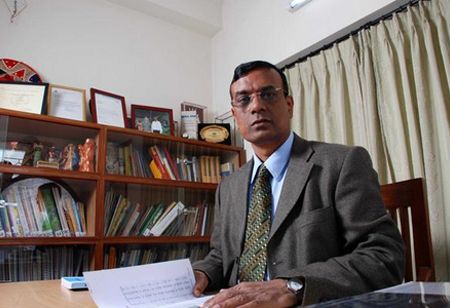
In Gruelling Adversity Rose an Unbeatable Chandra Shekar Gosh


Changing the lives of several underbanked and underprivileged people is a journey of success in banking that Bandhan Bank has lived up to this date. Behind this success story is a stern man who took the road less taken and triumphed with entrepreneurial spirits. We are talking about the inspiring journey of Chandra Shekar Ghosh, which is filled with adversity in entrepreneurship. Chandra Shekhar successfully built Bandhan into the largest microfinance organization in the nation.
Although it started 24 years ago, Chandra Shekar expanded Bandhan Bank to become a branch network with 1700 employees, a presence in virtually all states and union territories, and a revenue mix of almost Rs 2.60 lakh crore in just nine years. Over the past few years, it has reduced the size of its microfinance portfolio to less than one-third of its overall loan assets by diversifying into the retail and commercial asset sectors.
Eye-Opener Incidents
Chandra Shekhar spent his initial career at the Small Industries Development Bank of India (SIDBI) in the agricultural sector. There, he saw the bleak reality of financial struggles that the rural and economically disadvantaged populace faced, particularly on two defining occasions.
The first involved meeting a mother in the interiors of West Bengal who was unable to provide her three-year-old daughter with the meal she desired.
The second, also set in West Bengal, was a conversation with a vegetable vendor who borrowed a daily loan of Rs 500 and paid about an annual interest rate of 700 percent to a moneylender.
Upon deeper analysis, Chandra Shekar discovered that moneylenders were gobbling 200 percent to 300 percent from the impoverished people.
Birth of a Socialist Banker
With a firm mind to bring the economically backward out of poverty, Chandra Shekar established Bandhan, a non-governmental organization (NGO), in 2001 to provide microloans to underprivileged women. Armed with a passion and knowledge at the grassroots level, Chandra Shekar was able to expand Bandhan into a lifeline for many people and families.
Chandra Shekar first tested out his idea of empowerment by working with 25 impoverished women in a semi-urban district of Kolkata to improve their average monthly income from Rs 300 to Rs 2,000.
Although being a localized microfinance lender is one thing, to become a fully functional bank with a nationwide presence is quite another. Despite helping Bandhan in its transformation to become a bank, Deloitte did not find its progress up to its liking. The reason was that rural areas without access to banking did well for Bandhan’s growth despite the funds in such areas being insufficient to increase deposits at Bandhan Bank. Meanwhile, the urban districts have strong banking systems, with a clientele that has grown primarily on ICICI and Citibank products.
A Vision Beyond Microfinance
When it came to microfinance, Chandra Shekhar saw empowerment of the people as the defining factor of his vision.
To fulfill that reality meant making Bandhan a full-fledged bank. This was when one of the most important turning points in his journey came by transforming an NGO to Bandhan Bank. Finally, in 2015 saw the formal opening of Bandhan Bank.
Mapped Out Various Routes to Reach His Services to the People
Under his guidance, Bandhan Bank began to offer reasonably priced financial services to the underbanked and unbanked sections of society. He rolled out a vast range of financial services and products with each designed to meet the requirements of customers. Thanks to offering a plethora of services, millions of people who had not been able to use formal banking services before now had access to savings accounts, microloans, and other financial services.
Incorporation of Technology
Bandhan Bank's success can be largely attributed to Chandra Shekhar's innovative banking style. Well aware of the potential of technology, he guided the bank to adopt digital solutions and launched online and mobile banking applications. For example, he brought in portable devices to enable connectivity with communities and make contact with individuals who have money to park. It also values face-to-face communication with its clients in addition to using technology. This improved the convenience for customers, while increasing the accessibility range for those living in rural places for banking.
Made the Bank Reach People
Knowing the significance of having a physical presence, Chandra Shekar went on to make Bandhan Bank diversify into branches and other banking locations in outlying and rural areas. Now, the bank was able to reach even the most interior and remote parts and generate jobs in underserved areas as well.
Even in the Face of Adversities, His Will Did Not Falter
There were times that tested the leadership of Chandra Shekhar, such as shifting regulations and volatile markets. Yet, the bank's development and stability stood firm thanks to his clear strategic decisions and the ability to withstand and adapt to changes.
His Infinite Dedication to Uplift the Lives of People
As far as banking goes, Chandra Shekhar holds an infinite dedication towards upholding social responsibility. He has been actively involving himself in charitable endeavors, focusing on providing healthcare and education to impoverished areas. His commitment to social responsibility is part of his belief in building a society that is more inclusive and equal.
The remarkable story of Chandra Shekhar's rise from humble beginnings to the head of Bandhan Bank is a standing example of his commitment to promoting financial inclusion and creative banking methods. These methods have revolutionized not only Bandhan Bank but also the Indian banking sector as a whole. His story is a ray of hope, proving that anyone can overcome hardship and have a long-lasting impact on the lives of millions of people if they have the willpower and the will to bring about positive change.